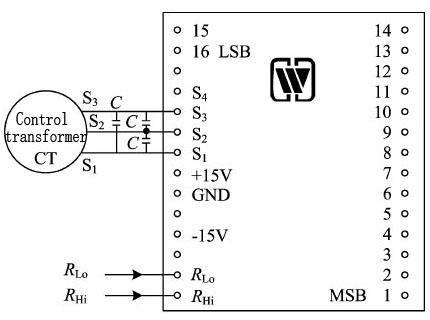1.Features (see Fig. 1 for outside view, and Table 1 formodels)
|
Compatible with DTL/TTL/CMOS level |
 |
|
12-bit, 14-bit and 16-bit resolution |
|
|
Short-circuit and overload protection |
|
|
Metal case, with good heatsinking |
|
|
Output power: 1.5W |
Table1 Product models
|
12-bit |
14-bit |
16-bit |
|||
|
Synchro |
Resolver |
Synchro |
Resolver |
Synchro |
Resolver |
|
MDSC2812-411 |
MDRC2812-418 |
MDSC2814-411 |
MDRC2814-418 |
MDSC2816-411 |
MDRC2816-418 |
|
MDSC2812-412 |
MDRC2812-438 |
MDSC2814-412 |
MDRC2814-438 |
MDSC2816-412 |
MDRC2816-438 |
|
MDSC2812-421 |
MDRC2812-414 |
MDSC2814-421 |
MDRC2814-414 |
|
MDRC2816-414 |
|
MDSC2812-422 |
MDRC2812-415 |
MDSC2814-422 |
MDRC2814-415 |
|
MDRC2816-41-36/11.8 |
|
|
|
|
|
|
MDRC2816-415 |
|
Absolute max. rated value |
Supply voltage +VS: +13.5~+17.5V Supply voltage -VS: -17.5~-13.5V Storage temperature range: -40~100℃ |
|
Recommended operating conditions |
Supply voltage +VS: +14.5~+16.5V Supply voltage -VS: -16.5~-14.25V Reference voltage (effective value) VRef: 115V±5% Signal voltage (effective value) V1: 90V±5% Reference frequency f: 400Hz±10% Range of operating temperature TA: -40℃~85℃ |
|
Parameter |
MDRC/MDSC2812 |
MDRC/MDSC2814 Enterprise military standard (Q/HW30857-2006) |
MDRC/MDSC2816 |
|
Resolution Accuracy Digital input Reference voltage (effective value) Reference frequency |
12-bit ±8 12-bit binary code |
14-bit ±4 14-bit binary code 26V/115V/4V 50Hz/400Hz |
16-bit ±4 16-bit binary code |
|
Output signal voltage (Effective value) |
11.8V (line-line, resolver or synchro) 90V (line-line, resolver or synchro) |
||
|
Input data speed Step response time Output power |
|
|
|
 |
 |
|
Fig.2 Schematic diagram of MDSC converter |
Fig.2 Schematic diagram of MDRC converter |
6. MTBF curve (Fig. 4) of MDSC/MDRC28 Series Digital to Synchro Converters or Digital to Resolver Converters |
7. Pin designation (Fig. 4, Table 4) of MDSC/MDRC28 Series Digital to Synchro Converters or Digital to Resolver Converters |
 |
 |
|
Fig. 4 MTBF-temperature curve (Note: according to GJB/Z299B-98, envisaged good ground condition) |
Fig.5 Schematic diagram of pins |
|
Pin |
Symbol |
Function |
Pin |
Symbol |
Function |
Pin |
Symbol |
Function |
|
1 |
1 (MSB) |
Digital input 1 |
11 |
11 |
Digital input 11 |
21 |
S1 |
Signal output 1 |
|
2 |
2 |
Digital input 2 |
12 |
12 |
Digital input 12 |
22 |
+15V |
+15V input |
|
3 |
3 |
Digital input 3 |
13 |
13 |
Digital input 13 |
23 |
GND |
Ground |
|
4 |
4 |
Digital input 4 |
14 |
14 |
Digital input 14 |
24 |
NC |
Leave unconnected |
|
5 |
5 |
Digital input 5 |
15 |
15 |
Digital input 15 (12-bit and 14-bit are leave unconnected) |
25 |
-15V |
-15V input |
|
6 |
6 |
Digital input 6 |
16 |
16 |
Digital input 16 (12-bit and 14-bit are leave unconnected) |
26 |
NC |
Leave unconnected |
|
7 |
7 |
Digital input 7 |
17 |
NC |
Leave unconnected |
27 |
RLo |
Low end of reference input |
|
8 |
8 |
Digital input 8 |
18 |
S4 |
Signal output 4 |
28 |
RHi |
High end of reference input |
|
9 |
9 |
Digital input 9 |
19 |
S3 |
Signal output 3 |
|
|
|
|
10 |
10 |
Digital input 10 |
20 |
S2 |
Signal output 2 |
|
|
|
|
Bit (MSB) |
Angle |
Bit (MSB) |
Angle |
Bit (MSB) |
Angle |
|
1 |
180.000 0 |
6 |
5.625 0 |
11 |
0.175 8 |
|
2 |
90.000 0 |
7 |
2.812 5 |
12 (for 12-bit LSB) |
0.087 9 |
|
3 |
45.000 0 |
8 |
1.406 3 |
13 |
0.043 9 |
|
4 |
22.500 0 |
9 |
0.703 1 |
14 (for 14-bit LSB) |
0.022 0 |
|
5 |
11.250 0 |
10 |
0.351 6 |
|
|











 X
X